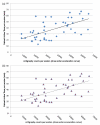Patient Active Time During Therapy Sessions in Postacute Rehabilitation: Development and Validation of a New Measure
- PMID: 25419032
- PMCID: PMC4235132
- DOI: 10.3109/02703181.2014.915282
Patient Active Time During Therapy Sessions in Postacute Rehabilitation: Development and Validation of a New Measure
Abstract
Background and purpose: The accurate measurement of therapy intensity in postacute rehabilitation is important for research to improve outcomes in this setting. We developed and validated a measure of Patient Active Time during physical (PT) and occupational therapy (OT) sessions, as a proxy for therapy intensity.
Methods: This measurement validity study was carried out with 26 older adults admitted to a skilled nursing facility (SNF) for postacute rehabilitation with a variety of main underlying diagnoses, including hip fracture, cardiovascular diseases, stroke, and others. They were participants in a randomized controlled trial that compared an experimental high-intensity therapy to standard-of-care therapy. Patient Active Time was observed by research raters as the total number of minutes that a patient was actively engaging in therapeutic activities during PT and OT sessions. This was compared to patient movement (actigraphy) quantified during some of the same PT/OT sessions using data from three-dimensional accelerometers worn on the patient's extremities.
Results: Activity measures were collected for 136 therapy sessions. Patient Active Time had high interrater reliability in both PT (r = 0.995, p < 0.001) and OT (r = 0.95, p = 0.012). Active time was significantly correlated with actigraphy in both PT (r = 0.73, p < 0.001) and OT (r = 0.60, p < 0.001) and discriminated between a high-intensity experimental condition and standard of care rehabilitation: in PT, 47.0 ± 13.5 min versus 16.7 ± 10.1 min (p < 0.001) and in OT, 46.2 ± 15.2 versus 27.7 ± 6.6 min (p < 0.001).
Conclusions: Systematic observation of Patient Active Time provides an objective, reliable, and valid index of physical activity during PT and OT treatment sessions that has utility as a real-world alternative to the measurement of treatment intensity. This measure could be used to differentiate higher from lower therapy treatment intensity and to help determine the optimal level of active therapy time for patients in postacute and other settings.
Keywords: Physical therapy; intensity; occupational therapy; rehabilitation; skilled nursing facilities.
Figures
References
-
- al-Khawaja I, Wade DT, Turner F. The Barthel Index and its relationship to nursing dependency in rehabilitation. Clinical Rehabilitation. 1997;11:335–337. - PubMed
-
- Bohannon RW. Time use by inpatients receiving neurorehabilitation. Perceptual and Motor Skills. 2003;97:68–70. - PubMed
-
- Chan L. The state-of-the-science: challenges in designing postacute care payment policy. Archives of Physical Medicine and Rehabilitation. 2007;88:1522–1525. - PubMed
-
- Davis PB, Morris JC, Grant E. Brief screening tests versus clinical staging in senile dementia of the Alzheimer type. Journal of the American Geriatrics Society. 1990;38:129–135. - PubMed
Grants and funding
LinkOut - more resources
Full Text Sources
Other Literature Sources

